3. Refraction of Light
- Books Name
- Iti Shree Science Book
- Publication
- Vaishnav Publication
- Course
- CBSE Class 10
- Subject
- Science
Refraction through a rectangular Glass slab
- The ray of light enters from rarer to denser medium at point O that is from air to glass and bends towards the normal.
- At ‘O’, the light ray enters from glass to air, that is, from a denser medium to a rarer medium. The light here bends away from normal.
- The emergent ray is parallel to the incident ray. However the light ray shifts slightly sideward.
- Refraction is due to change in speed of light when it enters from one medium to another.
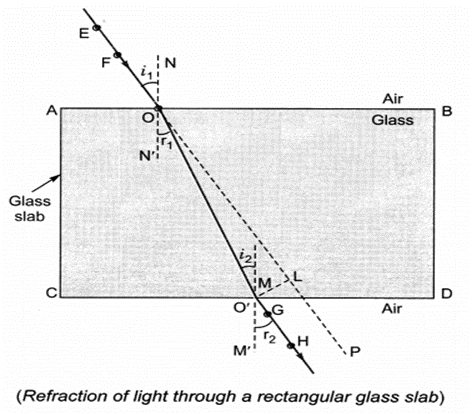
Refraction of light: Bending of the light rays as it passes from one medium to another medium is known as refraction of light.
Laws of refraction
Two laws of reflection are:
(i) The incident ray, the refracted ray and the normal to the interface of two transparent media at the point of incidence, all lie in the same plane.
(ii) The ratio of sine of angle of incidence to the sine of angle of refraction is constant for the light of a given colour and for the given pair of media. This law is also known as Snell’s law of refraction.
![]()
Refractive index: The extent of the change in direction of light that takes place in a given pair of media is expressed in terms of the refractive index. This can be expressed in an equation form as
![]()
Absolute refractive index: Refractive index of medium 2 with respect to vacuum is called the absolute refractive index of the medium. It is represented as n2.
Spherical lens: A transparent medium bound by two surfaces, of which one or both surfaces are curved is called a spherical lens.
Concave lens: It is a spherical lens in which two spherical surfaces bulge inwards. It is also called diverging lens.
Convex lens: It is a spherical lens in which two spherical surfaces bulge outwards. It is also called converging lens.
Refraction of light by spherical lens:

Image formation by Convex Lens
(i) When the object is at infinity
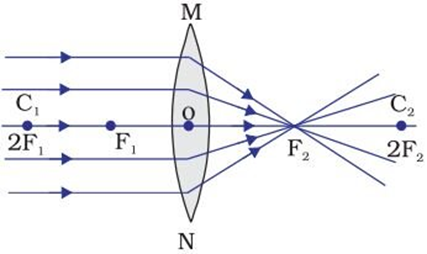
→ Image is formed at focus F2
→ Image is highly diminished or point-sized
→ Image is real and inverted
(ii) When the object is beyond 2F1
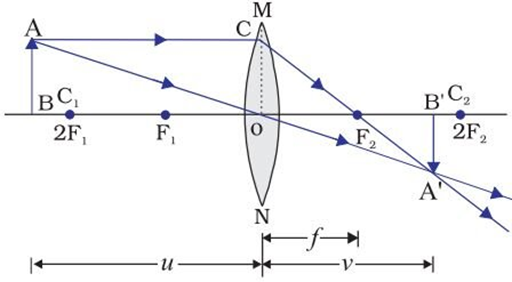
→ Image is formed between F2 and 2F2
→ Image is diminished
→ Image is real and inverted
(iii) When the object is at 2F1
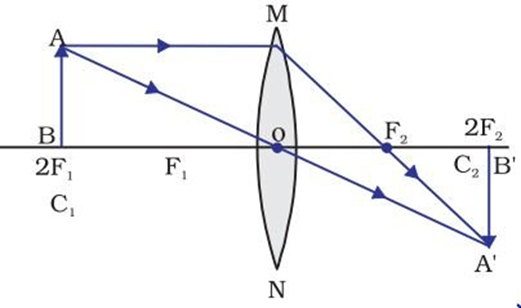
→ Image is formed at 2F2
→ Image is same size as that of object
→ Image is real and inverted
(iv) When the object is between F1 and 2F1
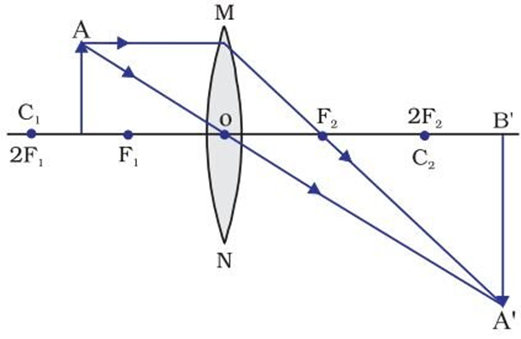
→ Image is formed beyond 2F2
→ Image is enlarged
→ Image is real and inverted
(v) When the object is at focus F1
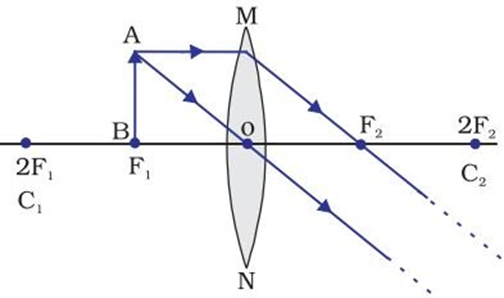
→ Image is formed at infinity
→ Image is infinitely large or highly enlarged
→ Image is real and inverted
(vi) When the object is between focus F1 and optical centre O
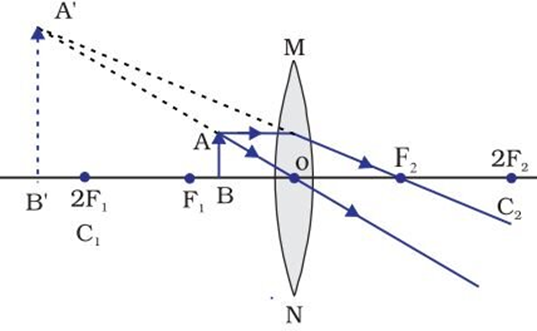
→ Image is formed on the same side of the lens as the object
→ Image is enlarged
→ Image is virtual and erect
2. Sign Convention of Mirror, Mirror Formula and Magnification
- Books Name
- Iti Shree Science Book
- Publication
- Vaishnav Publication
- Course
- CBSE Class 10
- Subject
- Science
Sign Conventions of Spherical Mirror
- All the distances are measured from the pole of the mirror as the origin.
- Distances measured in the direction of incident rays are taken as positive.
- Distances measured opposite to the direction of incident rays are taken as negative.
- Distances measured upward and perpendicular to the principal axis are taken as positive.
- Distances measured downward and perpendicular to the principal axis are taken as negative.
1f=1v+1u …where f, v and u are focal length, image distance, object distance
Rules for reflection of rays by spherical mirrors
(i) A ray of light from the object, parallel to the principal axis, after refraction from a convex lens, passes through the principal focus on the other side of the lens. In case of a concave lens, the ray appears to diverge from the principal focus located on the same side of the lens.

(ii) A ray of light passing through a principal focus, after refraction from a convex lens, will emerge parallel to the principal axis. A ray of light appearing to meet at the principal focus of a concave lens, after refraction, will emerge parallel to the principal axis.

(iii) A ray of light passing through the optical centre of a lens will emerge without any deviation.

Mirror formula

where, v = Image distance
u = Object distance
f = Focal length
Magnification
The size of an image relative to the size of the object creating it.
Linear magnification refers to the ratio of image length to object length measured in planes that are perpendicular to the optical axis. A negative value of linear magnification denotes an inverted image.
Magnification of Spherical Mirrors
![]()
where, h' = Height of the image
and h = Height of the object
Note -The height of the image should be taken as positive for virtual images. However, it is to be taken as negative for real images.
1. Reflection of Light
- Books Name
- Iti Shree Science Book
- Publication
- Vaishnav Publication
- Course
- CBSE Class 10
- Subject
- Science
Chapter 10
Light – reflection & refraction
REFLECTION
Reflection of Light: The phenomenon of bouncing back of light into the same medium by the smooth surface is called reflection.
Laws of Reflection:
There are two laws of reflection. They are:
(i) Angle of incidence is equal to the angle of reflection.
(ii) The incident ray, the reflected ray and the normal at the point of incidence, all lie in the same plane.
Incident light: Light which falls on the surface is called incident light.
Reflected light: Light which goes back after reflection is called reflected light.
The angle of incidence: The angle between the incident ray and the normal.
An angle of reflection: The angle between the reflected ray and the normal.
Mirror: The surface which can reflect the light is a mirror.
Plane Mirror: If the reflecting surface is a plane then the mirror is plane.
Spherical Mirror: If the reflecting surface is part of the hollow sphere then the mirror is a spherical mirror.
The spherical mirror is of two types:
- Convex mirror: In this mirror reflecting surface is convex. It diverges the light so it is also called a diverging mirror.
- Concave mirror: In this mirror reflecting surface is concave. It converges the light so it is also called converging mirror.
Parameters of Mirror:
- Centre of Curvature: The centre of hollow sphere of which mirror is a part.
- The radius of curvature: The radius of hollow sphere of which mirror is a part.
- Pole: The centre of mirror (middle point) is pole.
- Principal axis: The line joining the pole and centre of curvature is called principal axis.
- Aperture: Size of mirror is called aperture of mirror.
- Principal Focus: The point on the principal axis, where all the incident rays parallel to principal axis converge or diverge after reflection through mirror.
- Focal Length: The distance between pole and focus point is focal length.
Special Rays for Formation of Image:
- A ray of light which is parallel to the principal axis of a spherical mirror, after reflection converges or diverges from focus.
- A ray of light passing through or appearing from the centre of curvature of spherical mirror is reflected back along the same path.
- A ray of light passing through or appearing from the focus of spherical mirror becomes parallel to the principal axis.
- A ray of light which is incident at the pole of a spherical mirror is reflected back making same angle with principal axis.
Use of Concave Mirror: It is used as a makeup mirror, the reflector in torches, in headlights of cars and searchlights, doctor’s head-mirrors, solar furnace, etc.
Use of Convex Mirror: Convex mirror used as rear view mirror in vehicles, as shop security mirrors, etc.
1. Human Eye
- Books Name
- Iti Shree Science Book
- Publication
- Vaishnav Publication
- Course
- CBSE Class 10
- Subject
- Science
Chapter 11
Human Eye and colourful world
Human Eye
- It is one of the sensitive sense organs present in living organisms. It acts like a Camera.
- The image is formed on light sensitive screen known as Retina.
- Thin membrane through which light enters the eye is known as Cornea.
- The eyeball is spherical in shape.
- Presence of the crystalline lens helps in adjusting objects at different distances on the retina.
- The dark muscular structure that controls the size of the pupil is known as Iris. Thus, pupil regulates the amount of light entering the eye.
- Real, inverted image is formed on the retina. Retina contain light sensitive cells known as Rods and Cons. The light sensitive cells send signals to the brain via optic nerve.
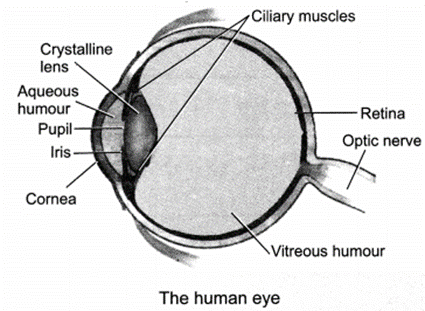
Power of Accommodation:
Focal lens of the eye lens can be decreased or increased. The lens become thin when the muscles are relaxed. This increases the focal length. This helps to see the distant objects. Similarly, when the eye lens become thick, focal length decreases and we are able to see nearby objects.
So, power of accommodation is defined as ability of the lens to adjust the focal length.
- The minimum distance at which the particular object can be seen clearly is known as least distance of distinct vision. This is also called Near Point of the Eye. For young individuals, near point is about 25 cm. The farthest point to which an object can be seen is known as Far Point of the Eye. This is about 25 cm to infinity.
- In old age people, the lens becomes milky and cloudy, this is known as Cataract. This can leads to complete or partial loss of vision.
Defects of Vision
The three common defects of vision are as follows-
- Myopia (also known as Near Sightedness). In this case, distant objects cannot be seen clearly but nearby objects are clearly visible. Image is not formed on the retina, instead it is formed in front of the retina. Using concave lens of suitable power can be used to correct this defect.

Correction of Myopia
Hypermetropia also known as Far-sightedness. Nearby objects are not seen clearly whereas distant objects can be seen clearly. Image is formed behind the retina instead on the retina. Convex lens of appropriate power can be used to correct this defect.

Correction of Hypermetropia
- Presbyopia is defined as the one in which power of accommodation decreases with ageing. They have difficulty in near vision. Ciliary muscles get weakened and the flexibility of the eye lens gets diminished. Generally, bifocal lens are used for correcting the defects.
2. Refraction of Light
- Books Name
- Iti Shree Science Book
- Publication
- Vaishnav Publication
- Course
- CBSE Class 10
- Subject
- Science
Refraction of Light through Prism
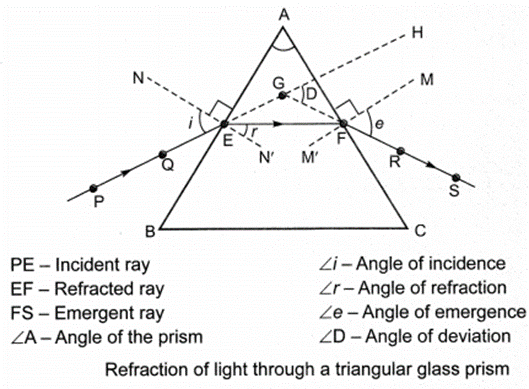
(i) The refraction of light takes place at two surfaces firstly when light enters from air to prism and j secondly when light emerges from prism.
(ii) Angle of prism: The angle between the two lateral faces of the prism is called angle of prism.
(iii) Angle of deviation: The angle between incident ray (produced forward) and emergent ray I (produced backward).
Dispersion of White Light by a Glass Prism
When light falls on the prism it splits the incident light into band of colours. The sequence of colours observed are VIBGYOR (Violet, Indigo, Blue, Green, Yellow, Orange and Red). This band of colour is known as Spectrum. So, this splitting of incident light into different colours is known as Dispersion. This splitting is due to bending of light rays at different angles. Violet light bends most whereas red light bends least. The phenomenon of rainbow is also due to dispersion of light.
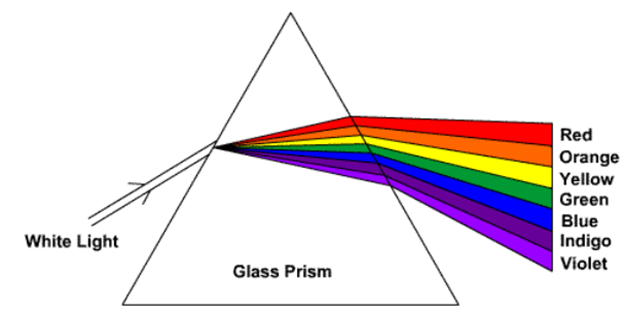
Dispersion of White Light through Prism
The band of these seven colours formed because of dispersion of light is known as Spectrum.
Atmospheric Refraction
Twinkling of Stars
When star light enters the atmosphere, it undergoes refraction. Due to this refractive index changes as the light bends towards the normal. The apparent position of the stars appears slightly different from the actual position. Since the physical conditions of the earth’s atmosphere are not stationary, the apparent positions of stars keep on changing. That is why they appear to twinkle.
Advance Sunlight and Delayed Sunset
The sun is visible 2 minutes before the actual sunrise or sunset appears 2 minutes after the actual sunset has taken place is due to atmospheric refraction.
When the sun is slightly below the horizon, the sunlight coming from the less dense (vacuum) to the denser (air) medium is refracted downwards. Therefore, the Sun appears to be above the horizon. Similarly, even after sunset, the Sun can be seen for some time due to refraction of sunlight.
3. Scattering of Light
- Books Name
- Iti Shree Science Book
- Publication
- Vaishnav Publication
- Course
- CBSE Class 10
- Subject
- Science
Tyndall Effect
When beam of light strikes tiny water droplets, suspended particles of dust etc. (called as Colloidal Particles), the path of the beam becomes visible. This is known as Tyndall Effect. The colour of scattered light depends upon the size of colloidal particles. Very fine particles scatter mainly blue light while particles of larger size scatter light of longer wavelengths.
Why sky appears blue in colour?
The colour of the sky appears blue due to scattering of light. When the sunlight passes through the atmosphere, fine particles in air will scatter the blue colour more strongly than red.
Why sky appears red in colour due to sunrise and sunset in atmosphere?
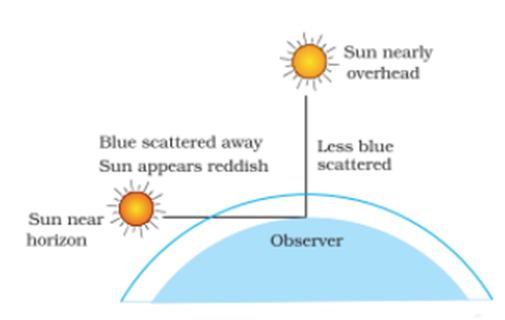
Reddening of Sun at rise and set
During sunrise and sunset, light from the Sun near the horizon passes through thicker layers of air and larger distance in the earth’s atmosphere before reaching our eyes. Light from the Sun overhead would travel relatively shorter distance, resulting in white appearance of sun. Near the horizon, most of the blue light and shorter wavelengths are scattered away by the particles. Therefore, the light that reaches our eyes is of longer wavelengths, hence the reddish appearance.
4. Image Formation by Lenses, Lens Formula, Magnification and Lens Power
- Books Name
- Iti Shree Science Book
- Publication
- Vaishnav Publication
- Course
- CBSE Class 10
- Subject
- Science
Image formation by Concave Lens
(i) When the object is at infinity
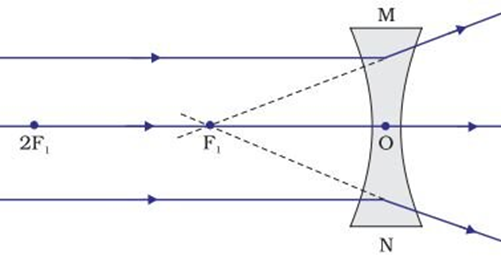
→ Image is formed at focus F1
→ Image is highly diminished or point sized
→ Image is virtual and erect
(ii) When the object between infinity and optical centre O of lens
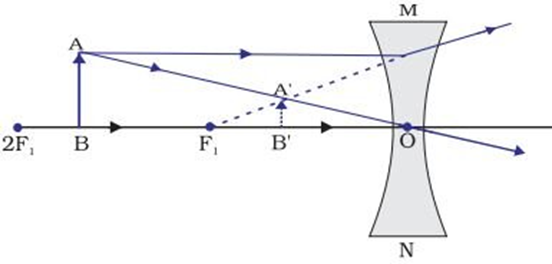
→ Image is formed between focus F1 and optical centre O
→ Image is diminished
→ Image is virtual and erect
Uses of Spherical lenses
In photographic cameras, magnifying glass, microscope, telescope, the human eye.
Sign convention for Spherical lenses
- All distances, object distance (u), image distance (v) and focal length f are measured from the optical centre.
- The distances measured in the direction of incident ray are taken as positive and distances measured against the direction of incident ray are taken as negative.
- All distances (heights) of objects and images above principal axis are taken as positive and those below the principal axis are taken as negative.
For the two lenses, the sign conventions take the form
- u is- ve, if the object is in front of the lens. (Real object)
- u is +ve, if the object is virtual.
- v is – ve, if the image is on the same side as that of the object. (Virtual image )
- v is +ve, if the image is real.
- Focal length of a concave lens is taken as – ve.
- Focal length of a convex lens is taken as +ve.
Lens formula
![]()
Magnification
![]()
Power of a lens: The degree of convergence or divergence of light rays is expressed in terms of power. It is given as: P = 1/f
→ The SI unit of power is dioptre (D).
→ Power of convex lens is positive.
→ Power of concave lens is negative.

 Carrier Point
Carrier Point
